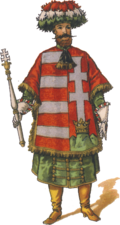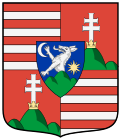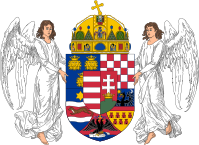Coat Of Arms Of Hungary
The coat of arms of Hungary (Hungarian: Magyarország címere) was adopted on 3 July 1990, after the end of communist rule.
The arms have been used before, both with and without the Holy Crown of Hungary, sometimes as part of a larger, more complex coat of arms, and its elements date back to the Middle Ages.
| Coat of arms of Hungary | |
|---|---|
 | |
| Versions | |
  The coat of arms may also be used in other historical forms. | |
 | |
| Armiger | Hungary |
| Adopted | 3 July 1990 |
| Crest | Holy Crown of Hungary |
| Shield | Barry of eight Gules and Argent, impaling Gules, on a trimount Vert a ducal coronet Or issuing therefrom a Patriarchal cross Argent |








The shield is split into two parts:
- The dexter (the right side from the bearer's perspective, the left side from the viewer's) features the so-called Árpád stripes, four Gules (red) and four Argent (silver) stripes. Traditionally, the silver stripes represent four rivers: Duna (Danube), Tisza, Dráva, and Száva.
- The sinister (the left side from the bearer's perspective, the right side from the viewer's) consists of an Argent (silver) double cross on Gules (red) base, situated inside a small Or (golden) crown, the crown is placed on the middle heap of three Vert (green) hills, representing the mountain ranges (trimount) Tátra, Mátra, and Fátra.
Atop the shield rests the Holy Crown of St. Stephen (Stephen I of Hungary, István király), a crown that remains in the Parliament building (Országház) in Budapest today.
History
Kingdom of Hungary
The most common motifs of the ninth and the early tenth centuries -the griffin, wolf and hind- seldom figure in later Hungarian iconography and heraldic symbolism, however the Hawk or Turul which in shamanistic lore rested upon the tree of life connecting the earth with the netherworld and the skies preserved for longer as a device belonging to the ruling house.
 | The 15th-century Ingeram Codex depicts the coat of arms of Hungary during the time of Saint Ladislaus I as a red double cross in a white background. | |
 | Béla III's (r. 1172–1196) was the first double-cross coat of arms. It already appeared on coins before. | |
 | The red and white stripes were the heraldic symbol of the House of Árpád, first used in the coat of arms in 1202 on one of Emeric's (r. 1196–1204) seals.[citation needed] This was the coat of arms of Emeric used on his 1202 golden bull. It shows nine lions. | |
 | On the Golden Bull of 1222, issued by Andrew II (r. 1205–1235), the stripes contain seven lions. | |
 | The coat of arms of Stephen V (r. 1270–1272) was a red triangle curved on all sides bordered by silver and black lines. At the bottom there's a trimount on a red field, from which a silver double-cross erects. On the lower part of it, there is a green wreath. | |
 | Andrew III (r. 1290–1301) used a red triangle-shaped shield with a curved side and a silver and black frame as his coat of arms. In the middle it contained the usual double-cross in silver color, but with a green wreath around the lower part and a pointed bottom. At the top on the left side it features a silver crescent, while on the left side, a silver six-pointed star. | |
 | The seal of Wenceslaus III (r. 1301–1305) shows the simple double cross with trimount. | |
 | When the House of Árpád became extinct and the Angevins came into power, they wanted to emphasize their legitimacy and their matrilineal relation to the previous royal house by using the Árpáds' coat of arms, the red and white stripes. Charles I combined this coat of arms per pale with the Angevins' fleur-de-lis. | |
 | Great coat of arm of King Matthias. In the middle are personal coat of arms of Matthias Corvinus (Quartered: 1. Hungary's two-barred cross, 2. Árpád dynasty, 3. Bohemia, and 4. Hunyadi family) and that of his wife Beatrice of Naples (Quartered: 1. and 4. Arpad dynasty – France ancient – Jerusalem Impaled; 2. and 3. Aragon), above them a royal crown. On the outer edge there are coat of arms of various lands, beginning from the top clockwise they are: Bohemia, Luxemburg, Lower Lusatia, Moravia, Austria, Galicia–Volhynia, Silesia, Dalmatia-Croatia, Beszterce county. | |
 | Louis I of Hungary quartered the red and white stripes of the Árpáds with the double cross on the trimount. This design was also used by John Zápolya, with his family arms in an inescutcheon. | |
 | The two coats of arms are often shown side by side in the 15th century. Their combination per pale, with the stripes on the dexter side and the cross with trimount on the sinister first appeared on coins during the reign of Vladislaus I (r. 1440–1444),[citation needed] and later on coins of Matthias Corvinus (r. 1458–1490). The crown above the coat of arms also appeared during the reign of Vladislaus I. At first it was only a non-specific diadem but on the 1464 seal of Matthias Corvinus it resembled more the Holy Crown of Hungary. The modern version of the coat of arms developed during the reign of Matthias II in the beginning of the 17th century. Its usage became regular during the reign of Maria Theresa. | |
 | During the Hungarian Revolution of 1848, following the dethroning of the Habsburg dynasty on 14 April 1849, the Holy Crown was removed from the coat of arms. The remaining small coat of arms is usually referred to as the "Kossuth Coat of Arms" (Hungarian: Kossuth-címer) after Lajos Kossuth, Regent-President of Hungary (so unlike the name suggests, it was not the coat of arms of the Kossuth family). In the large coat of arms, however, a laurel wreath replaced the crown both in the central piece and above the shield, as shown on the adjacent image. | |
 | In the following centuries, the coat of arms of Hungary became more and more complex. It included the coats of arms of the territories which were part of the Lands of the Crown of Saint Stephen: Croatia, Dalmatia, Slavonia, and Bosnia, but the so-called "small coat of arms" always remained the central piece. (The more complex ones were called "medium" and "large coat of arms".) The adjacent image shows the medium coat of arms, in official use (with some modifications) from the Austro-Hungarian Compromise of 1867 till the end of World War I (1918). The outer pieces (anti-clockwise from top left) are the coats of arms of Dalmatia, Slavonia, Bosnia (added in 1915), Fiume, Transylvania, and Croatia. When Hungary became part of the Habsburg monarchy, the coat of arms became a part of that of the Monarchy, but later it became of marginal importance and during the reign of Joseph II – who did not even have himself crowned with the Holy Crown – it was omitted from the coins. | |
 | Used from 1915 to 1918. After the revolution was repressed, the Hungarian coat of arms was not used again until the Austro-Hungarian Compromise of 1867, when the small coat of arms with the crown once more became a part of a more complex coat of arms, similar to the medium coat of arms shown above. The Hungarian arms also became part of the combined coat of arms of Austria-Hungary. |
Changes during the 20th Century
 | After World War I, during the time of the First Hungarian Republic a new coat of arms was introduced. The new arms was almost the same as the "small coat of arms" only with the monarchist elements removed to make it look more republican. |
 | The Hungarian Republic of Councils in 1919 totally abolished the traditional coat of arms and used the communist five-pointed red star on official documents. After the fall of the communists, the Kossuth coat of arms was used for a short while. |
 | After the restoration of the kingdom, the small coat of arms (with the Holy Crown and the two angels) became official until the First Vienna Award in 1938, when the government started to use the 1915 coat of arms officially again. |
 | During the occupation of Hungary by Nazi Germany in 1944–1945 at the end of World War II, the puppet government formed by the fascist Arrow Cross Party added the letter "H" (for Hungaria) and the Arrow Cross symbol to it. |
 | Following the military forces of Nazi Germany in Hungary being defeated by the Red Army, Soviet military occupation ensued, eventually leading to the creation of a communist government in Hungary. Between 1946 and 1949 the Kossuth-style coat of arms was used, then the Hungarian People's Republic introduced a new state coat of arms in line with socialist heraldry, with a layout closely resembling that of the Soviet Union's. |
 | During the 1956 revolution, the "Kossuth" Coat of Arms was used again. In old newsreels, the Kossuth badge can be seen painted onto the turrets of many revolutionary tanks fighting against the Soviet invasion in the streets of Budapest.[citation needed] Although this revolution was crushed quickly by the Soviet Red Army, the new Communist government did not reinstate the 1949–1956 coat of arms, and thus this coat of arms was used for about a year. |
 | A new coat of arms was created in late 1957, incorporating a more traditional heraldic escutcheon (bearing the Hungarian red-white-green tricolor) into the wreath-and-red-star framework of socialist heraldry. Its usage ended with the adoption of the current coat of arms in 1990. |
 | Since 1990 the historical crowned small coat of arms has served as the official symbol of Hungary. In the first democratically elected Parliament there was considerable debate about the depiction of the Holy Crown on the coat of arms. The liberal, opposition party (Alliance of Free Democrats, SZDSZ) proposed the Kossuth-style "Republican" version but the conservative government backed the historical, crowned one. |
Honours
- In May and June 1946 a set of eight stamps of Coat of arms of Hungary was issued. These are the issues of inflation.
- Further, a fourteen-stamp set of Arms and Post-horn were issued May and June 1946; these are also the issues of inflation.
- Four commemorative stamps were issued on 15 March 1948 as part of the series: Centenary of the beginning of Hungary's war for Independence.
- On 20 August 1949 three stamps of Arms of Hungary were issued on the occasion of the Adoption of the Hungarian Peoples' Republic's Constitution.
- On 23 May 1958 three stamps were issued to commemorate the first anniversary of the law amending the constitution.
- Between 1941–45 as many as 44 Postage-Due stamps of various denominations, watermarks and paper were issued.
Some other stamps were also issued.
See also
References
- Bálint Hóman: A magyar címer történetéhez ("Additions to the history of the coat of arms of Hungary"), 1920 [3] (Hungarian)
- Iván Bertényi: Államcímerünk kialakulása ("Emergence of the state coat of arms"), 2003 [4] (Hungarian)
- József Laszlovszky: A magyar címer története ("History of the Hungarian coat of arms"), Egyetemi Nyomda, Budapest, 1989, p. 39
13. colnect.com/en/stamps/list/country/6955-Hungary/year/1958/page/4. Mi:HU 1529A-32A, Sn:HU 1191–93, Yt:HU 1245–47. 14. colnect.com/en/stamps/list/country/6955-Hungary/year/1941/page/4,5. colnect.com/en/stamps/list/country/6955-Hungary/year/1942/page/4. colnect.com/en/stamps/list/country/6955-Hungary/year/1944/page/2,3. colnect.com/en/stamps/list/country/6955-Hungary/year/1945/page/10,11,12.
External links
- The Hungarian Coat of Arms
- History of the Coat of Arms of Hungary from Szeged University (in Hungarian, with pictures)
- Hungarian Coat of Arms (in French, with pictures)
- 2011 CCII law (on the use of Hungary's coat of arms and flag, as well as awards) from njt.hu
This article uses material from the Wikipedia English article Coat of arms of Hungary, which is released under the Creative Commons Attribution-ShareAlike 3.0 license ("CC BY-SA 3.0"); additional terms may apply (view authors). Content is available under CC BY-SA 4.0 unless otherwise noted. Images, videos and audio are available under their respective licenses.
®Wikipedia is a registered trademark of the Wiki Foundation, Inc. Wiki English (DUHOCTRUNGQUOC.VN) is an independent company and has no affiliation with Wiki Foundation.

